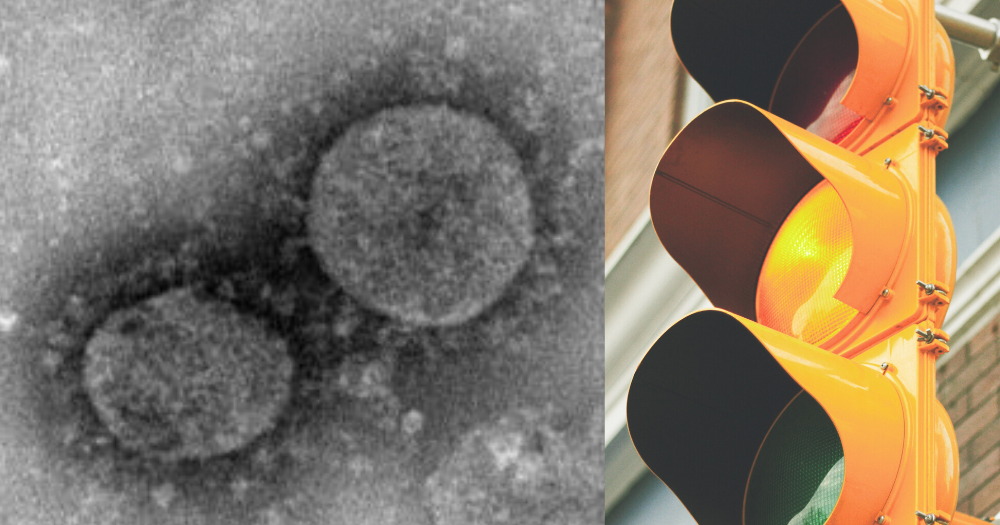The Ministry of Health (MOH) confirmed four additional cases of coronavirus in Singapore on Wednesday, Feb. 5.
This puts the total number of confirmed cases in Singapore at 28.
The current status of the coronavirus outbreak in Singapore, based on the Disease Outbreak Response System Condition (DORSCON), has been set as Yellow.
 Image screenshot from gov.sg.
Image screenshot from gov.sg.
But what do the colours mean, and what should we know moving forward? We explain below.
What is DORSCON?
DORSCON is part of Singapore's pandemic preparedness framework that serves as an indicator of disease situations.
DORSCON accounts for both the severity of the disease as well as its spread, in order to predict its impact on the community.
MOH's risk assessment for DORSCON includes the following:
- The current disease situation overseas.
- How transmissible the disease is.
- How likely it is to arrive in Singapore.
- What impact it may have on the local community.
DORSCON uses colour-coding to illustrate the different intensities of the disease situation, with Green being the most mild, followed by Yellow, Orange, and finally Red as the most heightened response.
What do the different colours mean?
Green
A Green DORSCON status indicates that either the disease is mild, or that it is severe but is not easily spread between people.
In terms of the impact of Green level diseases on daily life, they are minimally disruptive. Typical measures taken involve border screenings and travel advice.
Diseases that have fallen into this category in the past are the 2012 Middle East Respiratory Syndrome (MERS) outbreak and bird flu.
Yellow
Yellow means that the disease is severe and spreads easily, but outside of Singapore or that it is spreading in Singapore, but is typically mild or contained.
Diseases in this category also cause minimal disruption, although additional measures at the borders and/or healthcare settings can be expected, and it's likely that there will be more people than usual missing school or work.
An example of a DORSCON Yellow alert in the past is the 2009 swine flu pandemic.
Orange
Diseases in the Orange category are severe and spread easily, but have not spread widely in Singapore and are being contained.
Orange indicates that there will be moderate disruptions to daily life, including measures such as quarantine, temperature screenings, and visitor restrictions at hospitals.
At the Orange level, the public would be advised to comply with control measures set forth by the government.
Although the DORSCON framework was not yet set up during SARS, MOH reports that it would have been counted as Orange.
Red
Diseases that fall under the DORSCON Red category are those which are severe and spreading widely.
A disease of this level would likely cause major disruptions to daily life, such as through school closures and orders for employees to work from home, and would see a significant number of deaths.
Under these circumstances, members of the public would be advised to distance themselves socially by avoiding crowded areas.
Current situation in Singapore
Singapore currently falls within the DORSCON Yellow category, according to MOH, meaning that the coronavirus situation should cause minimal disruption to normal life.
While Singapore has implemented some of the measures categorised under DORSCON Orange, such as quarantines and temperature screenings, the current situation is still considered at Yellow.
According to the Straits Times, MOH said that is because the DORSCON categories are not set in stone, but rather are general guidelines for action.
MOH reportedly stated that Singapore has not shifted to Orange because there is currently only one cluster. If that cluster is contained, they said, that could stop the virus spread in Singapore.
Speaking at a press conference by the government's multi-ministry taskforce on the coronavirus on Tuesday, Feb. 4, Minister for Health Gan Kim Yong said that the status may yet change to Orange.
Gan said that this could happen if Singapore experienced widespread transmission in multiple clusters from unknown sources around the country.
He added that the government is watching the situation carefully and monitoring developments, and that they are prepared to adjust things as they go along.
Top image via National Microbiology Data Centre and David Guenther on Unsplash.
If you like what you read, follow us on Facebook, Instagram, Twitter and Telegram to get the latest updates.
